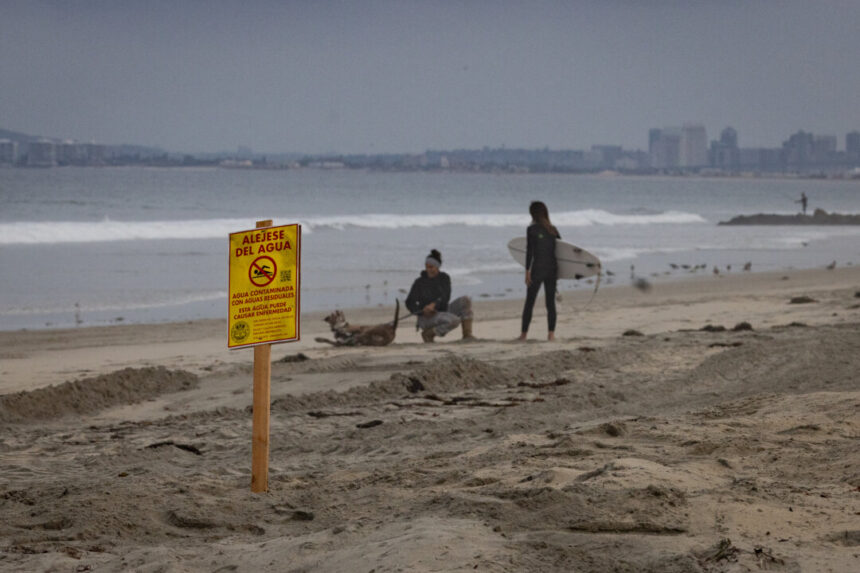More than 100 billion gallons of untreated sewage and industrial waste have contaminated California waters from the Tijuana River in the last five years.
IMPERIAL BEACH, Calif.—As the sun rose over Imperial Beach, warning signs lined the shore, cautioning beachgoers to avoid contact with the water, while a faint smell of rotten eggs lingered in the air.
“Most people now prefer to surf further north of here,” shared local surfer Jani Garcia, 39, looking out at the warning signs.
“But as you can see, there are still a few brave souls out there taking the risk, and in better surf conditions, I might do the same,” she added with a smile.
After being closed for over 1,015 days, much of the beach reopened on Sept. 23, allowing local surfers to return to their favorite spot without the fear of citations.
However, local officials warn that the health risk is not entirely eliminated.
In a unanimous vote earlier this month, the San Diego County Board of Supervisors decided to extend a local emergency declaration due to the high levels of pollution and sewage from the Tijuana River, initially declared in June 2023.

Water advisory signs line the sands of Imperial Beach, Calif., on Sept. 19, 2024. John Fredricks/The Epoch Times

Water advisory signs line the sands of Imperial Beach, Calif., on Sept. 19, 2024. John Fredricks/The Epoch Times
The Tijuana River flows from Tijuana, Mexico, into San Ysidro, a U.S. border city, and empties into the Pacific Ocean just south of Imperial Beach, around 17 miles south of downtown San Diego.
River Crisis
Over the past five years, more than 100 billion gallons of untreated sewage and industrial waste have flowed into California waters from the Tijuana River, as reported by the International Boundary and Water Commission.
“We are very concerned about the high flows and sediment entering the United States from Mexico in the Tijuana River,” shared International Boundary and Water Commission (IBWC) spokesperson Frank Fisher with The Epoch Times.
“It’s no secret that residents have been suffering for a long time, especially in Imperial Beach. This is what drives us to expand the South Bay treatment plant and, at the same time, pressure Mexico to enhance its wastewater infrastructure.”
The South Bay International Wastewater Treatment Plant is one of the facilities aiding in sewage treatment, serving as one piece of the puzzle in reducing pollution entering the United States.
On the Mexican side of the border, a pump station in Tijuana, responsible for diverting sewage before it reaches treatment stations in the U.S. along the Tijuana River, recently resumed operations after upgrades to the facility were completed earlier this month, officials confirmed.
“Infrastructure improvements are necessary to reduce the [sewage] flows. This is not something that local government can handle,” explained San Diego County Communications Officer for the Land Use and Environmental Group Donna Durckel to The Epoch Times.
“Ocean pollution due to the [Tijuana] River sewage flows falls under the jurisdiction of the Federal government and International Boundary and Water Commission.”
“Local researchers and government agencies have identified 392 organic chemical and inorganic elements, many of which are known to be persistent, bio-accumulative, carcinogenic, [and] toxic,” stated the letter.

The Tijuana River flows within sight of the US-Mexico border in Imperial Beach, Calif., on Sept. 19, 2024. John Fredricks/The Epoch Times

A lifeguard drives toward the Tijuana River mouth outside of San Diego, Calif., on Sept. 19, 2024. John Fredricks/The Epoch Times
John Fredricks/The Epoch Times
One year prior, Newsom sent a letter to the California Coastal Commission declaring that the condition of the Tijuana River was a “crisis,” but not worthy of an emergency declaration, according to the mayors.
However, in January, Newsom called on the federal government to supply funding to help address the river pollution, and in March, at least $100 million was provided to the county in the 2024 fiscal year appropriations package signed by President Joe Biden. Meanwhile, local officials say the crisis is ongoing.
Newsom’s office did not respond to The Epoch Times for comment by deadline.
Health Concerns
According to the mayor of Imperial Beach, pollution-related sickness has been on the rise in the beach community of roughly 26,000, along with the contaminated water flowing from the Tijuana River onto the California coastline.
“This river contains industrial waste, residential waste, agriculture waste, slaughterhouse waste—everything goes into the river and it’s getting worse,” Mayor Paloma Aguirre told The Epoch Times.
“As we look at our data we have collected, there is empirical evidence showing that there’s contamination in the soil, water, and even in the air with toxic gases that include hydrogen sulfide.”
According to Aguirre, residents in Imperial Beach and neighboring towns are reporting a higher rate of medical issues due to the river’s pollution, including gastrointestinal and respiratory illnesses.
Headaches are also common due to harmful gas build-ups that are created by such pollution, according to both county and federal health officials.
“Even as I’m speaking with you, I’m fighting off a migraine right now,” Aguirre said. “Migraines are now common [among] our residents and city staff which can be traced back to the [Tijuana] River’s offset of hydrogen sulfides.”
Also known as H2S, the gas is described by the U.S Occupational Safety and Health Administration as colorless, extremely flammable, and highly toxic—with a “rotten egg” type odor.
According to preliminary research from Sept. 18 by the University of California–San Diego, H2S levels in the area are “well above” air quality standards set by the California Air Resources Board. Researchers found the gas levels increased substantially at night.
“These gases seem to have their biggest impact between the hours of 12 to 6 a.m. for both Imperial Beach and neighboring communities according to research that has been done on this issue,” Aguirre told The Epoch Times.
“This is a health issue that concerns not just Imperial Beach but many others throughout San Diego.”
Meanwhile, earlier this month, San Diego County Supervisor Nora Vargas said the air quality in the area does not pose a public health threat, despite the foul odors and elevated levels of gases.
“I want to reassure everyone that this is not an imminent threat, and it’s safe to be outside and attend school,” Vargas said at a news conference. “Our county experts are actively gathering public health data and conducting research to provide the most accurate information.”
Pollution Continues
On the banks of the Tijuana River, the foul scent of rotten eggs grew stronger as the rising sun heated its waters, surrounded by heaps of trash within sight of the United States border wall and Tijuana city skyline.
According to Imperial Beach city officials, a team from the Centers for Disease Control and Prevention (CDC) has been dispatched to investigate the health concerns created by the Tijuana River local to the area in the coming days.
“It’s the first time the CDC has ever come to San Diego, is my understanding,” Aguirre told The Epoch Times.
“This crisis has permeated to San Diego’s communities, [and] what matters is that people’s health and lives are at risk.”
San Diego County health officials recommend checking SDBeachInfo.com for information on water safety before entering the ocean in the region.
City News Service contributed to this report. Please rewrite this sentence.
Source link








